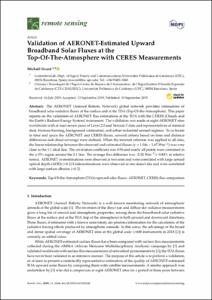Validation of AERONET-estimated upward broadband solar fluxes at the top-of-the-atmosphere with CERES measurements

Visualitza/Obre
Cita com:
hdl:2117/169141
Tipus de documentArticle
Data publicació2019-09-01
EditorMultidisciplinary Digital Publishing Institute (MDPI)
Condicions d'accésAccés obert
Llevat que s'hi indiqui el contrari, els
continguts d'aquesta obra estan subjectes a la llicència de Creative Commons
:
Reconeixement-NoComercial-SenseObraDerivada 3.0 Espanya
ProjecteACTRIS-2 - Aerosols, Clouds, and Trace gases Research InfraStructure (EC-H2020-654109)
GRASP-ACE - Development of GRASP radiative transfer code for the retrieval of aerosol microphysics vertical-profiles from space measurements and its impact in ACE mission (EC-H2020-778349)
A2F Conference - Presidency Conference on Access to Finance for Research, Innovation and Growth (EC-H2020-638327)
GRASP-ACE - Development of GRASP radiative transfer code for the retrieval of aerosol microphysics vertical-profiles from space measurements and its impact in ACE mission (EC-H2020-778349)
A2F Conference - Presidency Conference on Access to Finance for Research, Innovation and Growth (EC-H2020-638327)
Abstract
The AERONET (Aerosol Robotic Network) global network provides estimations of broadband solar radiative fluxes at the surface and at the TOA (Top-Of-the-Atmosphere). This paper reports on the validation of AERONET flux estimations at the TOA with the CERES (Clouds and the Earth’s Radiant Energy System) instrument. The validation was made at eight AERONET sites worldwide with at least seven years of Level 2.0 and Version 3 data and representatives of mineral dust, biomass burning, background continental, and urban-industrial aerosol regimes. To co-locate in time and space the AERONET and CERES fluxes, several criteria based on time and distance differences and cloud coverage were defined. When the strictest criterion was applied to all sites, the linear relationship between the observed and estimated fluxes (y = 1.04x – 3.67 Wm-2) was very close to the 1:1 ideal line. The correlation coefficient was 0.96 and nearly all points were contained in the ±15% region around the 1:1 line. The average flux difference was –2.52 Wm-2 (–0.84% in relative terms). AERONET overestimations were observed at two sites and were correlated with large aerosol optical depth (AOD) (>0.2) Underestimations were observed at one desert site and were correlated with large surface albedos (>0.2
CitacióSicard, M. Validation of AERONET-estimated upward broadband solar fluxes at the top-of-the-atmosphere with CERES measurements. "Remote sensing", 1 Setembre 2019, vol. 11, núm. 18, p. 1-15.
ISSN2072-4292
Versió de l'editorhttps://www.mdpi.com/2072-4292/11/18/2168
| Fitxers | Descripció | Mida | Format | Visualitza |
|---|---|---|---|---|
| remotesensing-11-02168-v2.pdf | 1,968Mb | Visualitza/Obre |


